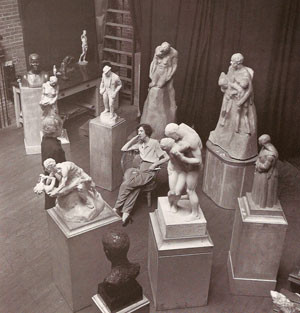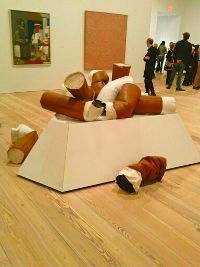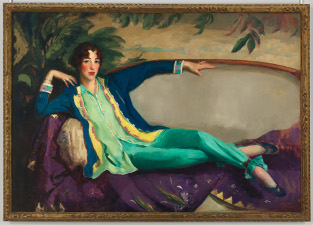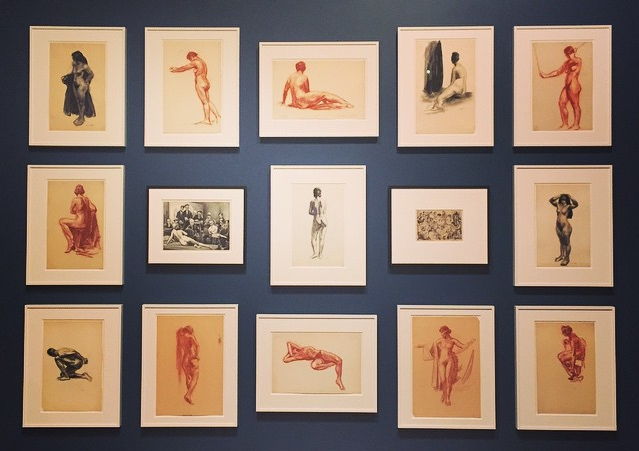CURATOR'S CHOICE SM
Exhibition Reviews
| Home | | Museum
Guide | | International |
| Theater |
Julia Slaff
| The
“new” Whitney Museum of American Art
Friday, May 1 was the opening day of The “new” Whitney Museum of American Art, in the trendy Meat-Packing District on 99 Gansevoort Street. Even 18 days after its Downtown inauguration, a block-long line of museum-goers anxiously waited outside the Whitney’s front doors to purchase tickets at 10:30 in the morning. “America is Hard to See” is the museum’s premier exhibition, on display from May 1 to September 27, 2015. It asks the question: What is American Art?
The inquiry is answered using art from The Whitney archives displayed through the entire museum. “America is Hard to See” looks at art from the early 20th century to the present, with more than 600 pieces on display. The works are laid out in an interesting way. The first gallery space shows works from The Whitney’s 1914 origins. Works outside this space, in the lobby and cafe areas, are contemporary. “America is Hard to See” is concentrated primarily from floors eight to six with corresponding terrace spaces to show outdoor sculptures. Ascending the elevator from the six floor, one is sent further back in time. Screening rooms on the third floor show media presentations from other parts of the gallery space. The elevators and stairs also act as exhibition spaces. The Whitney has pulled out all the stops for their first show in this new location - no space is left to waste. As the exhibition guide notes, the floors are further subset into 23 thematic “chapters” in the building. Their combinations and variations act to expand the definition of American art. Because of the diversity apparent in the American art scene, each chapter is named for a work within it over any particular style or movement. For example, a section on the seventh floor dedicated to the Abstract Expressionism movement is titled “New York, N.Y., 1955” for Hedda Sterne’s painting. The show elaborates on the “themes, ideas, beliefs, and passions” that the museum theorizes that American art comprises. The show delves into the struggle of American artists against the conventions of the overarching traditions of European art, using their political and social frames of understanding as inspiration.
The exhibition’s title is derived from an Emile de Antonio documentary. De Antonio took this name from a Robert Frost poem. The title is a metaphor, celebrating changing artistic perspectives and their development of visual modes responding to cultural shifts in the United States - which is very much the mission of this American museum. Art works from across the media spectrum are displayed side by side, related or not, to explore this metaphor. The show acts as a “collective memory” of ideas towards of American art through time. Whitney curators state in the exhibition guide that this exhibition is not a display of a comprehensive survey; rather, is “a critical new beginning: the first of many stories to still tell.”
The first floor of the exhibition is called “Eight West Eighth.”
It focuses on the early days of the the Whitney Museum of Art. Founded
in 1814 by Gertrude Vanderbilt Whitney, it opened as an exhibition space
and in 1918 developed it into the Whitney Studio Club with the assistance
of her aid, Juliana Force. The studio was like the Algonquin Round Table
but for the artistically minded folk. This section provides modern viewers
evidence of the different activities and tastes of the club. Paintings
include those from a group of artists known as “The Eight,”
later called the Aschan School, advocates of a “new and gritty
urban realism” akin to their times. Members of the school included
Robert Henri, William Glackens, John Sloan, Everett Shinn, and George
Luks. Interior shots of Eight Street Exhibitions by Charles Sheeler
and Berneice Abbott are hung on the traditional dark gallery walls.
Comical watercolors chronicle the original Whitney Studio Club by Guy
Pene Du Bois, the namesake of this gallery section. A
The exhibition is open through September 27, 2015, but there will be staggered closings before and after this date. To further unravel the interlocking “chapters” of the fascinating exhibition, I will be doing an article series investigating them. My intention is to go through each floor, evaluating the significance of each chapter to the overall themes of American art. Please check back. [Julia Slaff]
|




